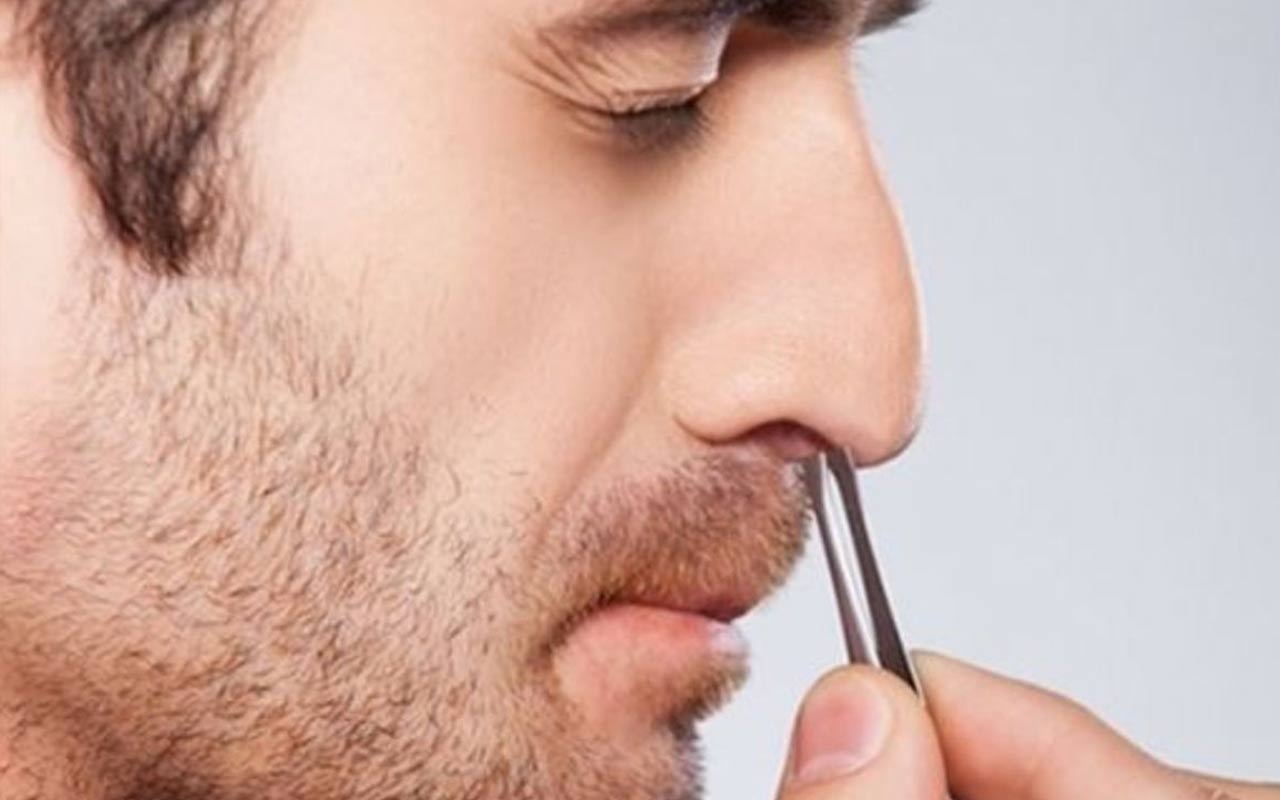Nasal vestibulitis (or nasal folliculitis) is a rare form of bacterial infection that occurs at the nose’s opening. It can look like a small bump or sore in the nose. It can often occur after hair follicles become infected. For example, after someone picks at their nose or pulls out their nose hairs.
Nasal vestibulitis can also be increased by certain cancer treatments. The nasal vestibule is the area between your nostrils. It is the entrance to your nasal cavity.
Nasal vestibule inflammation is caused by excessive blowing or picking at the nose. Although it is often easy to treat, severe complications can occur.
Infections are often caused by the bacteria Staphylococcus Aureus. Secondary causes of infection include chronic rhinorrhea, viral infections, and URIs. Nose picking is also a possible secondary cause.
Other infections such as folliculitis can cause pimples at the root of nasal hairs, which can lead to crust formation in the nostrils.
This article will provide information about nasal vestibulitis and the treatments available. It also includes when you should see a doctor.
Facts:
- Some forms of nasal vestibulitis are contagious, while other forms are not. It all depends upon the root cause. Indirect contact can spread contagious nasal vestibulitis.
- Researchers believe the infection could spread to the brain or skull, even though it is unlikely to occur. The first-line treatment for nasal vestibulitis is to apply a warm compress to infected areas a few times daily.
- Nasal vestibulitis is a condition that occurs when people pick their noses too often. Nasal vestibulitis can also be caused by recurrent infections of the nose and folliculitis.
- The infection can be treated quickly with medical attention in just a few days. Although it is not considered a serious condition in most cases, it can lead to severe complications in some rare cases.
- Nasal vestibulitis is not a serious condition but it can lead to severe complications in some cases.
- Nasal vestibulitis is usually treated with mupirocin or Bacitracin cream. You may need to use the ointment for several weeks.
- Nasal vestibulitis can usually be treated using topical antibiotic creams such as bacitracin or mupirocin. These ointments may need to be used twice daily for up to 14 days. You will be given oral antibiotics if you have any boils or pimples on your nose.
- Nasal vestibulitis can cause a bad smell in your nose. This is caused by bacteria overgrowth on the frontal nostrils.

Table of Contents
What is nasal vestibulitis?
Nasal vestibulitis is when there is an infection in your nasal vestibule. The nasal vestibule is located inside your nostrils. It is the starting point of your nasal passages.
Nasal vestibulitis, also known as excessive nose picking and blowing, is an infection of the nasal vestibule. It’s usually quite easy to treat but can sometimes cause serious complications.
Continue reading for more information about nasal vestibulitis symptoms.
Nasal Vestibulitis Symptoms
The cause and severity of the infection will determine the extent of symptoms. Common symptoms are:
- The nostrils may experience redness or swelling.
- The nose is tender and painful
- An identified, pimple-like bulge within the nostril
- Folliculitis: Crusty bumps and crust around the base hair follicles
- Cress in the nostrils
- Boils on your nose
- Drain the pus from the affected region
- An increase in body temperature
What causes nasal vestibulitis?
The most common reason for nasal vestibulitis is a Staphylococcus infection. This is a common cause of skin infections. A small lesion in the nasal vestibule is usually caused by:
- Plucking the hairs in your nostrils
- Blowing your nose too much
- You can clean your nose.
- Piercing of the nose (leaves nose prone to infections)
Listed below are some possible infectious causes:
- Herpes simplex virus infections and herpes zoster viral infections.
- A chronic runny nose is caused by an allergy or a respiratory infection.
- Infections of the upper respiratory tract.
A condition called nasal vestibulitis is an infection of the vestibule (or the entrance to the nose).
Staphylococcus aureus bacteria cause most infections.
While anyone can contract this infection, there are certain risk factors that increase the likelihood of someone getting it.
These risk factors are:
A weak immune system: Certain conditions like diabetes and Medicines can weaken your immune system, which increases your risk of infection.
People who clean their noses frequently can cause small cuts through the skin that can allow bacteria to enter.
Other areas such as the mouth and hands can also be infected by nose-picking.
Plucking nose hairs: Plucking nose hairs can cause irritation and tiny tears which could increase the chance of infection.
Regular wetting: may cause irritation and swelling of the nose. Blowing your nose can spread the bacteria to other parts of the nose.
Nose Piercings: The openings for infection may be created by nose piercings. The body treats the wound as an open wound and bacteria can get in.
Treatment for cancer: Chemotherapy weakens your immune system and makes you more susceptible to certain infections.
It can also dry out your nose, which could cause it to crack open, or bleed, which could allow infection to enter.
In 2015, it was discovered that patients who received targeted treatment drugs to treat certain cancers have a greater chance of developing nasal vestibulitis.
Bacterial Nasal Diseases
Bacteria could cause pimples or boils (furuncles), just outside each nostril’s opening (the nose vestibule).
Vibrating nasal
Minor infections of the nose (called nasal vestibulitis) can cause pimples around the base of the nasal hairs (folliculitis), or crusts around your nostrils.
The most common reason is Staphylococcus bacteria. The infection could be due to excessive nose picking or nasal blowing. This causes irritation and crusts that bleed when they slough off.
Nasal vestibulitis can usually be treated with mupirocin or bacitracin. It is possible that the ointment will need to be used for several weeks.
Nasal furuncles
Furuncles, which are more serious infections, can result in boils in the nasal vestibule. The nasal furuncles can spread to the skin and cause cellulitis at the tip.
This is where a doctor worries about infections. The veins that lead to the brain are located there.
Cavernous sinus thrombosis is a potentially fatal condition where bacteria can travel to the brain through the veins.
A person with a nose furuncle takes an antibiotic by the mouth and uses mupirocin to moisten hot clothes three times per day for approximately 15 to 20 min.
Large boils may need to be removed by a doctor if they are resistant to antibiotic treatment.
Nasal vestibulitis (NV), nasal furunculosis(NF), or nasal vestibular fuunculosis(NVF) refers to a localized infection in the hair-bearing nose vestibule.
Dahle suggested NVF as the name for the nasal vestibule. The acute focal symptoms are present. They can be caused by minor trauma like nose picking, hair plucking, or topical nasal steroid usage.
Mild cases may be treated with warm compresses, topical mupirocin, and/or hot compresses. Oral antibiotics are recommended if the patient does not respond.
Systemic antibiotics are recommended for severe cases such as those involving abscess formation or midfacial cellulitis.
These can lead to serious intracranial complications.
- Ophthalmic vein thrombosis
- Cavernous sinus thrombosis
- Orbital abscess
However, when taking antibiotics, we need to be very careful and follow the instructions of the doctor. O
ur noses, sinuses, and nasal passages are full of beneficial bacteria, but mainly due to the overuse of antibiotics, we have turned the colonies in our noses into more harmful bacteria.
Among these are bacteria such as Streptococcus pneumonia, Haemophilus influenza, and Staphylococcus sp., which lead to a number of common sinus and throat infections that frequently plague humans.
The “danger zone” of the face is infected. This includes the area from the corners to the bridge of the nose to the bridge.
The spread of infection is dependent on the communication between the facial and cavernous sinuses.
Treatment
The course of treatment for the nasal vestibular will depend on the severity of the condition. Most cases of nasal vestibulitis can be treated with topical antibiotic creams, such as bacitracin ointment or mupirocin. Most of these ointments are available at drugstores.
Use a cotton swab to apply these ointments to the inflamed area 2 times a day, continuously for 2 weeks. In some cases of severe nasal vestibular inflammation leading to a boil in the nose, your doctor will prescribe oral antibiotics along with a topical ointment.
You should consult your primary care physician or ENT specialist if you have any doubts about your condition.
It may be beneficial to apply heat three times daily to relieve large boils. This will allow you to do so for between 15 and 20 minutes. In rare cases, large boils may require surgery to remove the boil.
Home treatment for nasal vestibulitis
Applying warm compresses to the affected area several times a day is the best home treatment for the early-stage nasal vestibular disease. Rose geranium oil also helps in the treatment of nasal vestibulitis. It may speed up the healing process. A 2018 study proved that rose geranium oils also might help to reduce side effects from certain cancer treatments.
Rose geranium oil can be used to lower the chance of infection for patients undergoing chemotherapy. Be sure to wash your hands after using the oil. Dirty hands can spread bacteria to the area.
If your condition does not improve or you feel worse, you need to immediately go to the nearest medical facility for examination.
To prevent infection from spreading, your doctor may suggest that you drain the furuncle and have it removed surgically. Do not attempt to boil at your home. This can increase the chance of infection.
There are many other ways to decrease the chance of getting the infection again or spreading it. Here are some suggestions:
- Avoid plucking the nose hairs.
- Avoid picking the nose.
- Wash the hands before touching or blowing the nose.
- Only blow the nose as much as is absolutely necessary.
- Ask a doctor about strategies for minimizing nose dryness.
- Seek appropriate treatment for any other medical conditions, such as diabetes.
When to see a doctor?
The majority of cases of nasal vestibulitis can be treated, particularly if the patient seeks treatment early.
Consult a doctor if you:
- The nose may feel irritated or itchy.
- Nasal vestibulitis symptoms don’t improve even after taking antibiotics for a few more days.
- After starting antibiotics, the infection spreads to other people or the person develops a fever.
- When someone is receiving chemotherapy or takes drugs that weaken the immune systems, their nose may become dry, cracked, or itchy.
Nasal vestibulitis should not be considered an emergency. A fever is an emergency.
However, anyone with a compromised immune system should visit the emergency room immediately.
Ask your healthcare professional about any other symptoms. Chills and fatigue could be signs that the infection is spreading.
Nasal vestibulitis: What are the complications?
Nasal vestibulitis can also cause complications in more serious cases. Common complications include:
- Cellulite formation
- Cavernous sinus thrombosis
- Folliculitis
Prevention
It is important to consult an ENT physician in order to prevent the development of sinus infections.
You should also wash your nose often and avoid touching it with sharp objects or your fingers.
SUMMARY
A sinus infection or allergy can lead to severe pain.
Infections can be managed quickly by seeking medical attention within a matter of days. While not a serious condition like nasal vestibulitis, in rare cases it can cause severe complications.
Do not delay treatment as this will allow the infection to spread.

